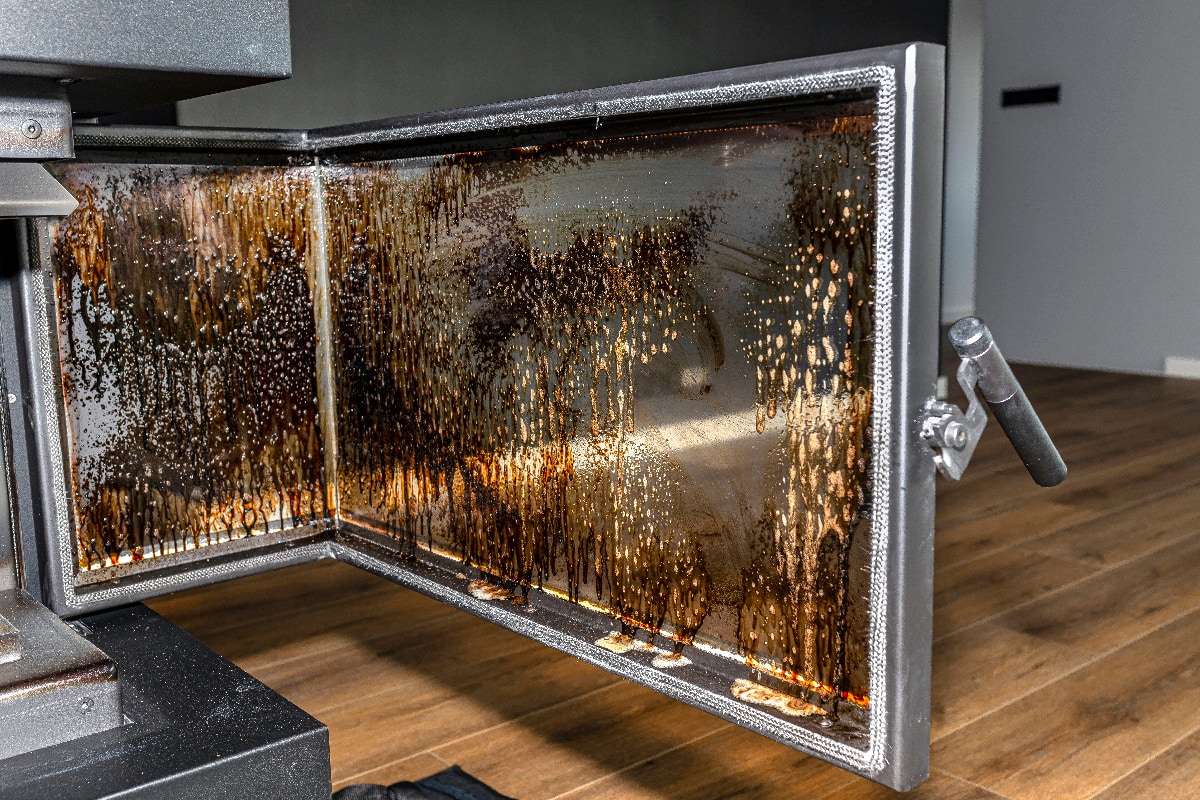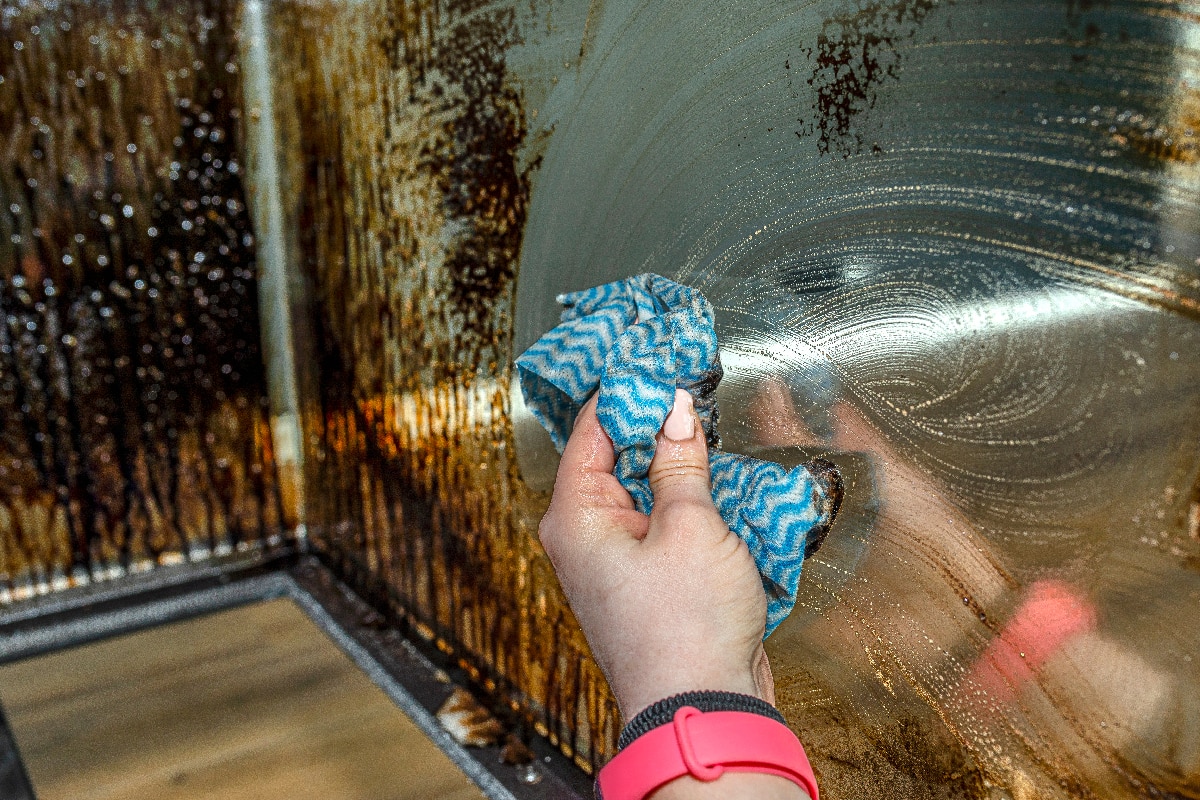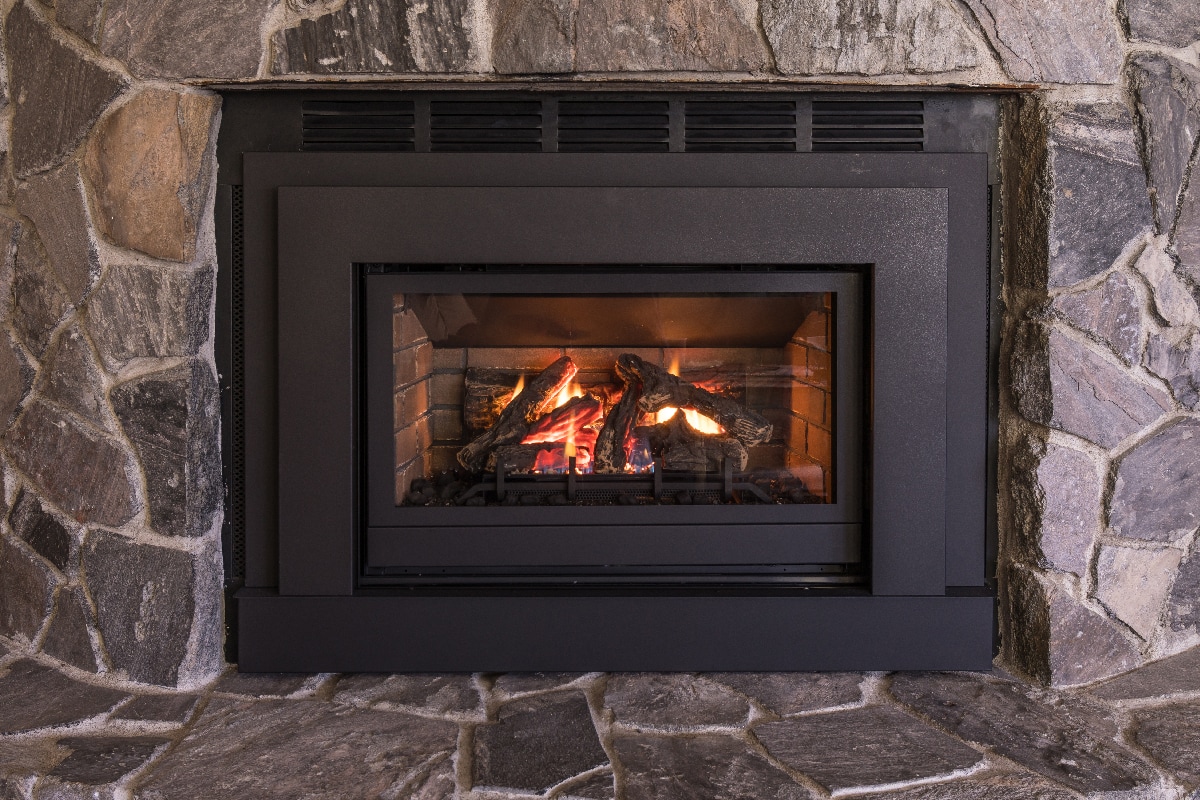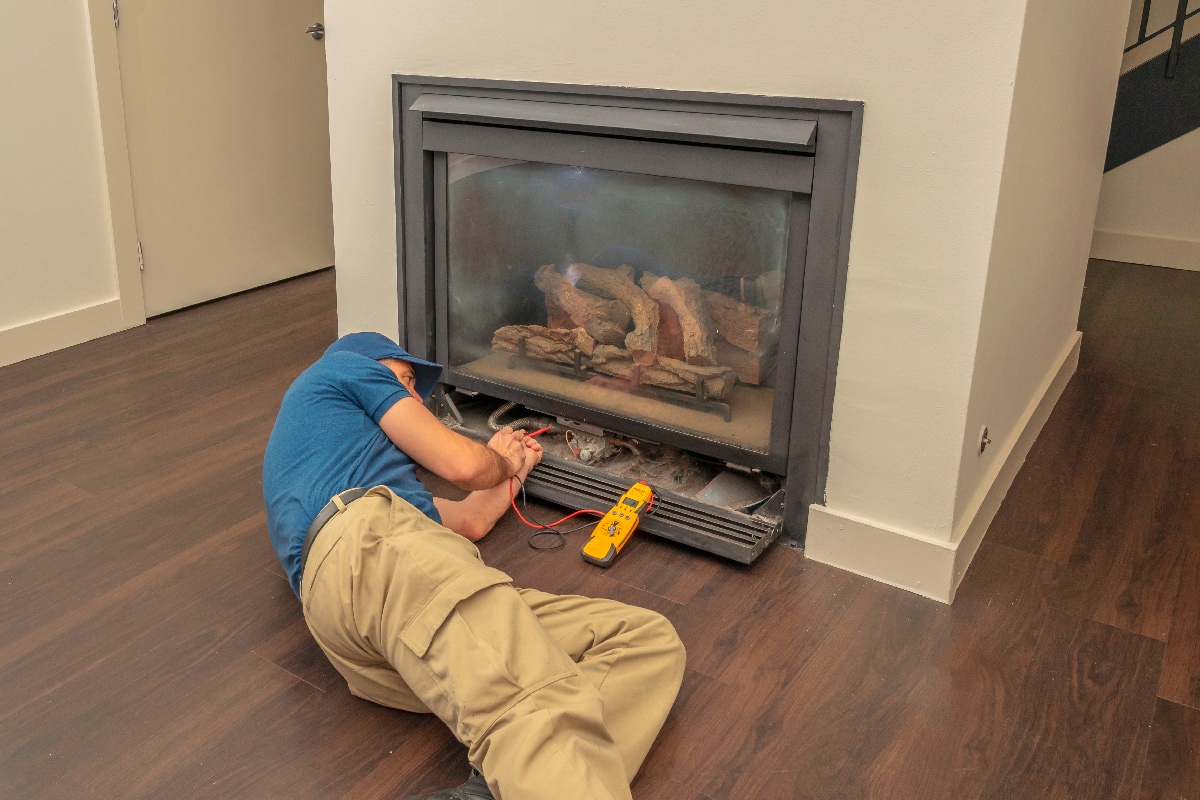A gas fireplace can be a beautiful addition to any home, but it can also cause health problems. One of these problems is the black soot that accumulates on the fireplace over time. We have researched this issue and will explain what this soot is and what you should be doing about it.
The black soot is not dangerous unless it has accumulated to such an extent that it is getting into the house and affects breathing. Black soot from gas fireplaces is a carcinogen, which means it causes cancer.
In this article, we will take a closer look at the health risks associated with soot. We will also talk about some tips you can use to remove it. This will be beneficial for you as it could help you avoid the risk of breathing in smoke particles from the fireplace.
![A burning wood in a modern fireplace with a closed combustion chamber, Is Black Soot From Gas Fireplace Dangerous? [What Homeowners Need To Know!]](https://hvacseer.com/wp-content/uploads/2022/09/Is-Black-Soot-From-Gas-Fireplace-Dangerous-What-Homeowners-Need-To-Know.jpg)
What Is A Soot?
Soot particles in the air are created by a process called pyrolysis, which occurs when fuels, such as wood, coal, natural gas, plastics, or organic materials are burned. It is formed by incomplete combustion, usually caused by the presence of oxygen.

Soot is also created from various fuel types. Diesel engines create the most soot, followed by gasoline and natural gas engines. Soot is produced in large quantities when fuel is burned.
Soot is the residue left behind from burning, which can be harmful if inhaled in large quantities. The fine soot particles are suspended in the air and could be breathed into the lungs.
As a result, soot can be harmful. When soot particles enter a house, they can cause health problems by depositing themselves on the surfaces of rooms. They can also irritate people's eyes and lungs, particularly children and people with respiratory conditions.
When inhaled, these particles become deposited on the lung lining (alveolar epithelium) where they cause inflammation. This results in an increased number of phagocytic cells, called alveolar macrophages, in the lungs.
The macrophages engulf the soot particles and release chemicals that cause the alveolar walls to thicken and become fibrotic.
Prolonged exposure to soot can also increase the risk of cancer of the scrotum and skin.
Not only is soot a health hazard, but it is also a pollutant that harms the environment. It settles out in a wide variety of ways, depending on the properties of the materials it's made of.
In some cases, soot will form a coating on the surfaces of objects. For instance, soot coats the insides of gas fireplaces, chimneys, and smokestacks. It also coats the air itself, creating clouds of smog.
How To Remove Soot In Gas Fireplace
Are the gas fireplace logs in your house blackened by soot? If that’s the case, you’re probably wondering how to get rid of the soot. We’re here to tell you about the steps you can take to clean up the fireplace.
1. Make Sure Your Gas Fireplace Is Off
You don't want to get hurt while cleaning up a fireplace, but it's also important to make sure that you don't accidentally turn on the gas and start a fire.
2. Remove The Logs
It is recommended that you remove fireplace logs in a manner that will allow the fireplace to operate efficiently. If you take out the logs and return them to their places after cleaning without following a certain order, it could affect the fireplace's operation.
3. Prepare A Drop Cloth
In case your fireplace’s logs have thick soot all over, you can easily remove them from the fireplace.
For safety and sanitary reasons, wear gloves when you’re about to grab or pull the logs out. A respirator mask is a great additional safety measure that you should take before getting into the fireplace.
While removing the logs, take care to not damage them or the fireplace. The sides of the fireplace that hold the logs in place might be thin and fragile, so you need to be careful not to knock them out of position.
The garage space is perfect to lay down your drop cloth. You can use anything like plastic, cardboard, or even paper to avoid a soot mess on the floor.
4. Vacuum Visible Signs Of Soot On The Logs
Ceramic logs are the most common type of gas fireplace logs. They are made of natural clay and are generally quite durable. Since they're made of clay, they have naturally high heat resistance.
Ceramic logs can last for years. However, they will start to show signs of wear and tear over time. For instance, there will be small cracks, holes, or crevices that will allow for the entry of soot and dirt.
To clean them, you can use a handheld vacuum to suck up the soot and dust. Use a damp cloth to wipe the ceramic logs clean. You may also soak them in a solution of white vinegar and lukewarm water for about half an hour.
5. Wipe Dry Using A Clean Rag
A dry microfiber cloth can be used to clean ceramic fireplace logs. These are soft, non-abrasive, and won’t harm the material. However, it can be a challenge to get into small crevices and cracks on the log’s surface.
Use the same type of cloth to clean your fireplace glass fronts, too. It's gentle enough not to scratch the glass.
6. Clean The Interior Of Your Gas Fireplace

If the soot in your fireplace has accumulated to the point that it is too thick, then it can be removed by the use of a brush. The type of brush to use will depend on the severity of the issue.
Brush every nook and cranny of the gas fireplace interior and also the fireplace firebox and firefront. You will need to use a fireplace brush that is made specifically for the job. These brushes have a series of bristles that will reach deep into the crevices of the fireplace.
If you have a gas fireplace, you will need to clean the logs periodically. This is necessary for the safety of your home. If you do not, then you may end up breathing in the soot that is produced by your fireplace.
Check out this brush on Amazon.
Here's a video showing more additional tips and insights on how to fix soot build-up on your gas fireplace:
How To Reduce Soot Formation In Gas Fireplace
Most gas fireplaces are designed to burn natural gas and are equipped with a venting system to exhaust fumes. When a venting system is in place, a technician is needed to inspect the system and determine if it needs maintenance or repairs.
The technician should examine the entire system if he wants to improve the combustion and minimize soot formation. They need to make sure the air intake shutters are clean and check the air-to-fuel ratio and make necessary adjustments to it to ensure proper combustion.
You should see the correct air-to-fuel ratio in your gas fireplace's manual.
In addition, soot formation can also be reduced by replacing your gas fireplace burners. When your gas fireplace gets old, the metal in its burners may oxidize, which will cause it to corrode.
This will lead to a loss of efficiency. Carbon buildup is accelerated especially when there is a significant loss of efficiency.
How Long Do Gas Fireplace Logs Last?

A vented gas fireplace log set will last as long as the fireplace itself, between 10 to 15 years. A well-maintained fireplace should have an airflow vent that is free of obstructions.
On the other hand, a vent-free log set has a sealed airflow system that prevents the smoke from coming out. This is not an ideal situation especially if you're living in an area with high humidity or where the ambient air temperature is constantly below freezing.
However, if you use your fireplace frequently, you will notice that the logs begin to lose their structural integrity after a few years.
How Much Cost For Replacing Gas Fireplace Logs?
It actually depends. When you are looking for a gas fireplace log set, you should know how much these logs cost and what are the pros and cons of each type. You may find some gas fireplaces at a great price, but they might not be worth it.
A gas fireplace log set is not something that is meant to be replaced every year or every two years. Rather, it is meant to last longer than that. So, when choosing a fireplace log set, you should think about the lifetime of the fireplace and whether it is worth the cost.
Gas fireplace logs are available in different shapes and sizes. As far as the type of fireplace logs that you use in your fireplace, the cost is determined by the size and shape.
For instance, the size of the fireplace log determines the amount of gas required to heat the room. In addition, the shape and design of the logs will determine the aesthetics of the fireplace and will cost as well.
As such, you should know the cost of replacing fireplace logs before you make a purchase. An informed decision will always give you a bang for your buck.
Check out these gas fireplace logs on Amazon.
How Often Should You Get Your Gas Fireplace Checked?

Inspecting and maintaining your gas fireplace is one of the most important aspects of your gas fireplace system. A professional fireplace inspection is essential to identifying and correcting problems that may occur, therefore, it is required that you have your gas fireplace checked at least once a year.
In Closing
Gas fireplaces produce smoke as a normal byproduct of combustion. This smoke is generally grayish-brown in color and is composed of fine particles of carbon and other materials generated during the burning process.
These particles are suspended in the air and may affect the health of people who inhale them. However, a gas fireplace is safe when it is properly maintained. If the gas fireplace is well maintained, it will produce little or no soot, which is a sign of good maintenance.
If you found this article helpful, you might also like:


